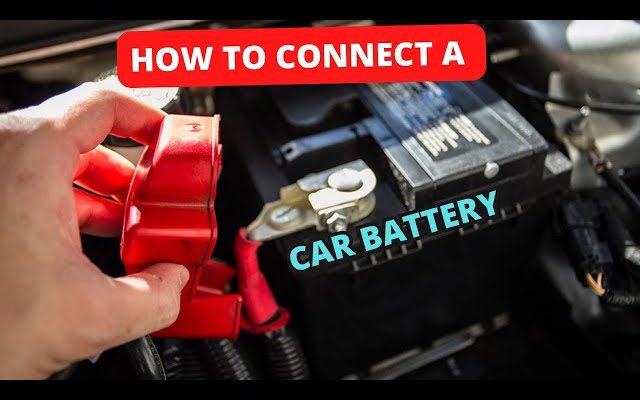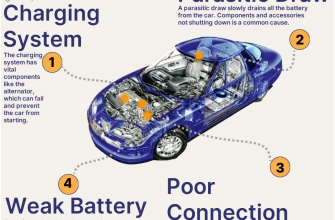When it comes to car maintenance, few topics are as crucial as understanding your vehicle’s battery connections. The color-coded wiring system—red for positive and black for negative—might seem straightforward, but the implications of these connections are anything but. Let’s delve into the intricacies of car battery connections, ensuring you’re equipped with the knowledge to handle battery issues safely and effectively.
The Basics of Car Batteries
Before we dive into the connections themselves, it’s essential to grasp what a car battery does. The battery provides the initial power needed to start the engine and supplies energy to the electrical systems when the engine isn’t running. It’s a lead-acid battery, which means it relies on a chemical reaction between lead plates and sulfuric acid to generate electricity.
Color Coding: Why Red and Black?
The red and black wiring system is a universal standard in automotive design, aimed at preventing confusion during installation and maintenance. Understanding this color coding is the first step to safely managing your battery connections.
- Red Wires: These are always connected to the positive terminal of the battery. The positive terminal typically has a “+” sign, and it’s vital to ensure that any connections here are secure and free from corrosion.
- Black Wires: These connect to the negative terminal, marked with a “-” sign. The negative connection is equally important, as it completes the circuit and allows current to flow.
Connecting Your Battery: Step-by-Step Guide
Whether you’re jumping a dead battery or replacing it, knowing how to connect the terminals correctly is vital. Here’s a step-by-step guide:
- Turn Off Everything: Before you start, ensure all electrical systems in your car are turned off; This includes the ignition, lights, and any accessories.
- Identify the Terminals: Locate the positive (red) and negative (black) terminals on your battery.
- Connect the Positive Terminal First: Attach the red cable to the positive terminal. Ensure it’s snug and secure.
- Connect the Negative Terminal: Next, attach the black cable to the negative terminal.
- Double-Check Connections: Before starting the car, double-check that your connections are correct. An incorrect connection can lead to serious damage.
Safety Precautions
While connecting batteries can be straightforward, safety should always be your top priority. Here are some precautions to consider:
- Wear Protective Gear: Safety glasses and gloves can protect you from battery acid and sparks.
- Check for Damage: Ensure that cables and terminals are not frayed or corroded.
- Avoid Sparks: Never allow the positive and negative cables to touch each other, as this can create a spark and potentially ignite flammable gases emitted by the battery.
Common Issues with Battery Connections
Understanding the common pitfalls can save you time and money. Here are a few issues to watch for:
- Corrosion: White, ashy deposits can build up on terminals. Clean these with a mixture of baking soda and water.
- Loose Connections: Ensure all connections are tight. Loose cables can lead to poor electrical performance.
- Dead Batteries: If your battery frequently dies, it might be time for a replacement or to check the alternator.
Understanding car battery connections is a fundamental skill for any car owner. The color-coded system of red and black wires simplifies the process, but it’s essential to approach battery maintenance with knowledge and caution. By following the guidelines laid out in this article, you can ensure that your car’s electrical system functions smoothly and safely. Whether you’re jump-starting a battery or replacing it entirely, being informed is the first step to success on the road.
So the next time you pop the hood, remember: red is for positive, black is for negative, and a little knowledge goes a long way in keeping your vehicle running smoothly.
Understanding battery connections is just the beginning. To ensure your car runs smoothly, regular maintenance of the battery itself is equally crucial. A well-maintained battery can significantly extend its life, enhance performance, and improve your vehicle’s overall reliability. Let’s explore some key maintenance tips that every car owner should know.
Regular Inspections
It’s essential to inspect your battery regularly for any signs of wear or damage. Look for:
- Cable Condition: Check for frayed or cracked cables. Damaged cables can lead to poor conductivity and eventual failure.
- Corrosion: Inspect the terminals for any buildup of white or greenish substance. This corrosion can impede the electrical connection.
- Cracks and Leaks: Examine the battery casing for any cracks or leaks. A leaking battery can be hazardous and should be replaced immediately.
Keeping Terminals Clean
Maintaining clean battery terminals is vital for optimal performance. To clean them:
- Disconnect the Battery: Always start by disconnecting the negative terminal first, followed by the positive terminal.
- Use a Cleaning Solution: Mix baking soda with water to create a paste. Apply it to the corroded areas.
- Scrub Gently: Use an old toothbrush or a wire brush to scrub the terminals clean.
- Rinse and Dry: Rinse with water and dry the terminals thoroughly before reconnecting.
- Reconnect the Battery: Attach the positive terminal first, then the negative terminal.
Battery Testing
Regular battery testing can help you catch problems before they lead to failure. You can use a multimeter to check the voltage or take your vehicle to a professional for a load test. A healthy battery should register around 12.6 volts or more. If it falls below 12.4 volts, it may be time for a replacement.
Temperature Considerations
Temperature can significantly impact battery performance. Extreme heat can accelerate battery fluid evaporation, while cold temperatures can reduce battery efficiency. Here are a few tips for different climates:
- Hot Climates: Consider using a battery insulation blanket to protect against heat.
- Cold Climates: Ensure your battery is fully charged before winter. Cold weather can reduce the battery’s capacity by up to 50%.
Understanding Lifespan and Replacement
Most car batteries last between three to five years, depending on usage and maintenance. Keep track of your battery’s age and performance to know when to replace it. Signs that it may be time for a new battery include:
- Frequent jump starts needed
- Dim headlights and electrical issues
- Swollen or misshapen battery casing
Proper car battery maintenance goes hand-in-hand with understanding connections. By regularly inspecting, cleaning, and testing your battery, you can prevent issues that could leave you stranded. Remember, a little TLC for your battery can go a long way in enhancing your vehicle’s performance and reliability. So, the next time you check your battery connections, take a moment to ensure it’s in top shape, setting the stage for smoother drives ahead.










Fantastic guide on connecting batteries! The step-by-step approach makes it easy for anyone to follow. Thank you for sharing!
I appreciate the detailed explanation of the color coding. It’s such a simple yet crucial aspect of car maintenance that many overlook.
This article is incredibly informative! I always struggled with understanding battery connections, but now it seems so clear. Great job!
Your step-by-step guide is brilliant! I feel much more confident about handling my car’s battery now. Thanks for the tips!
I love how you broke down the complexities of battery connections into manageable parts. Very helpful for beginners like me!
This is a must-read for all car owners. Knowing how to handle battery connections can save you time and money in the long run.
I learned so much from this article! Understanding the basics of car batteries is essential, and you explained it perfectly.
Excellent resource on car battery maintenance. The visuals would be a great addition to help clarify even further!
Great article! The emphasis on safety while connecting batteries is crucial, and I appreciate your thoroughness in explaining it.